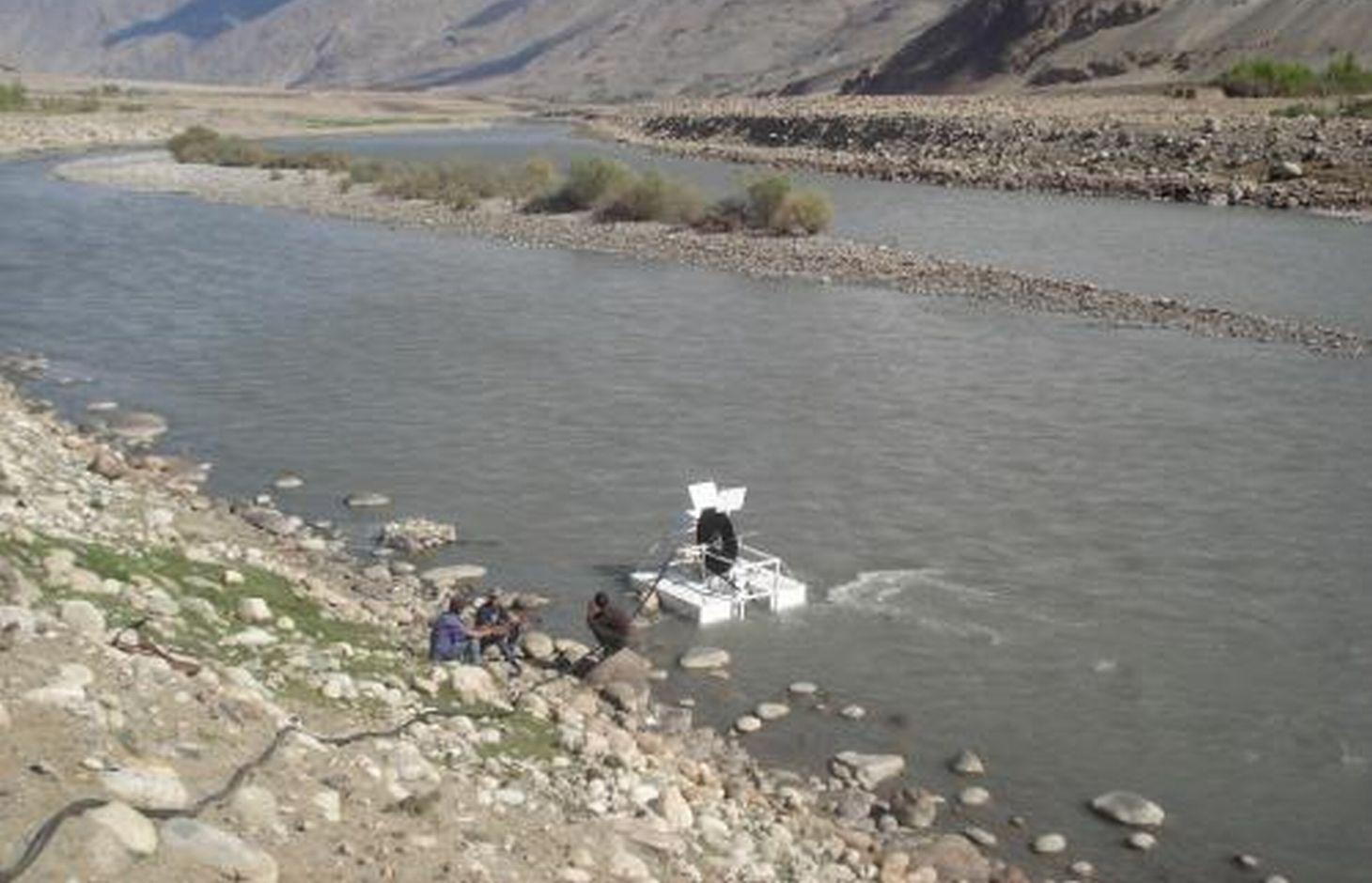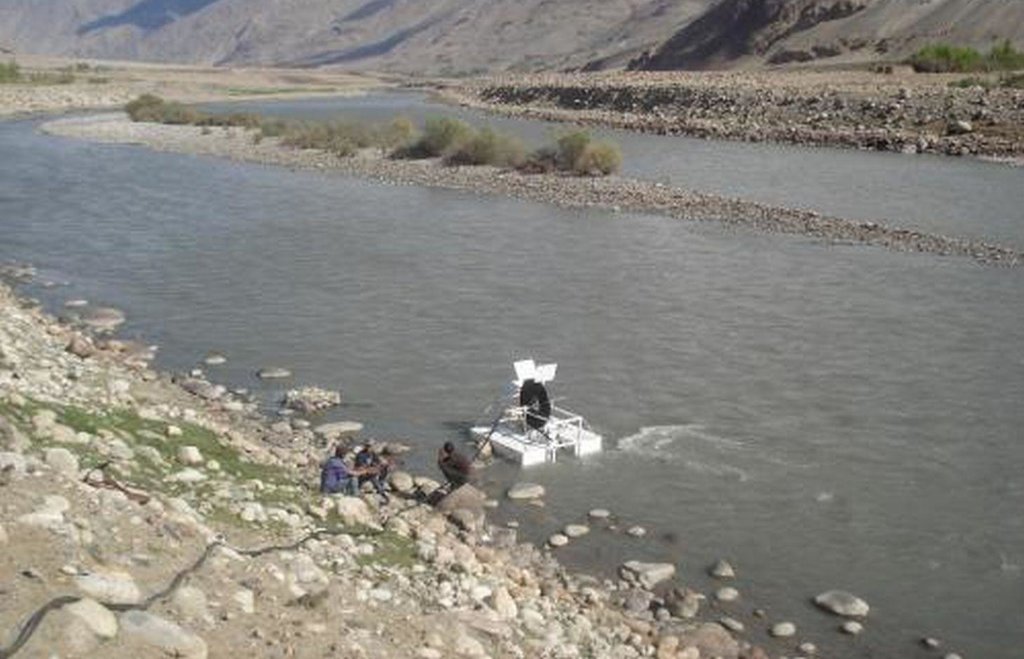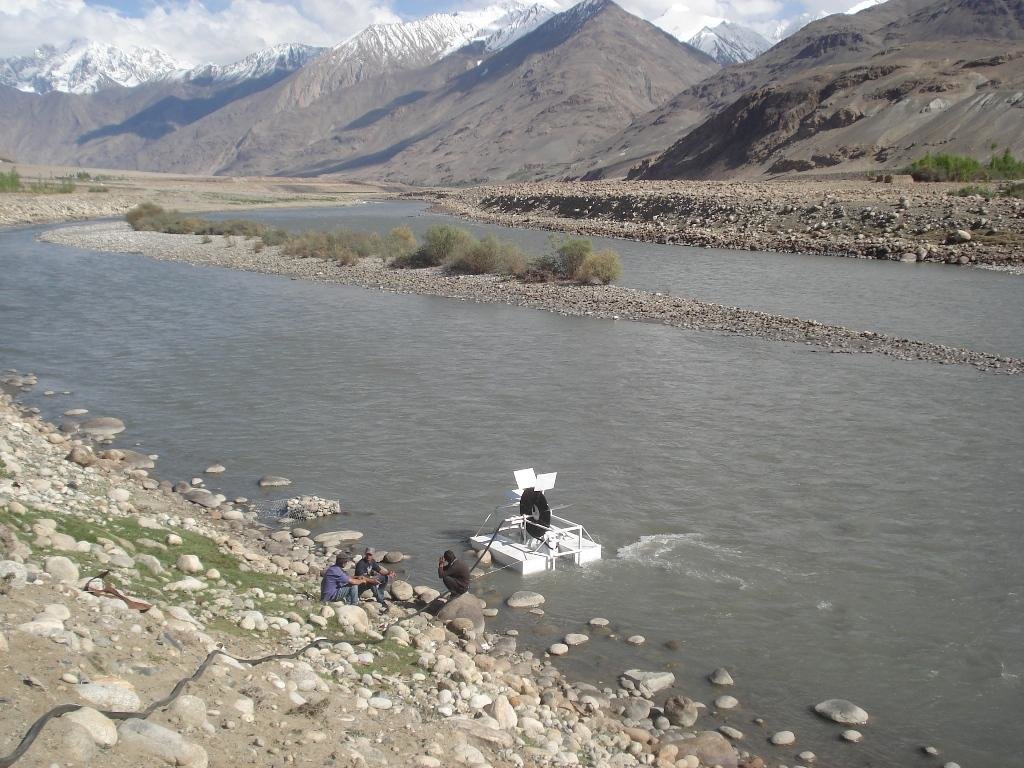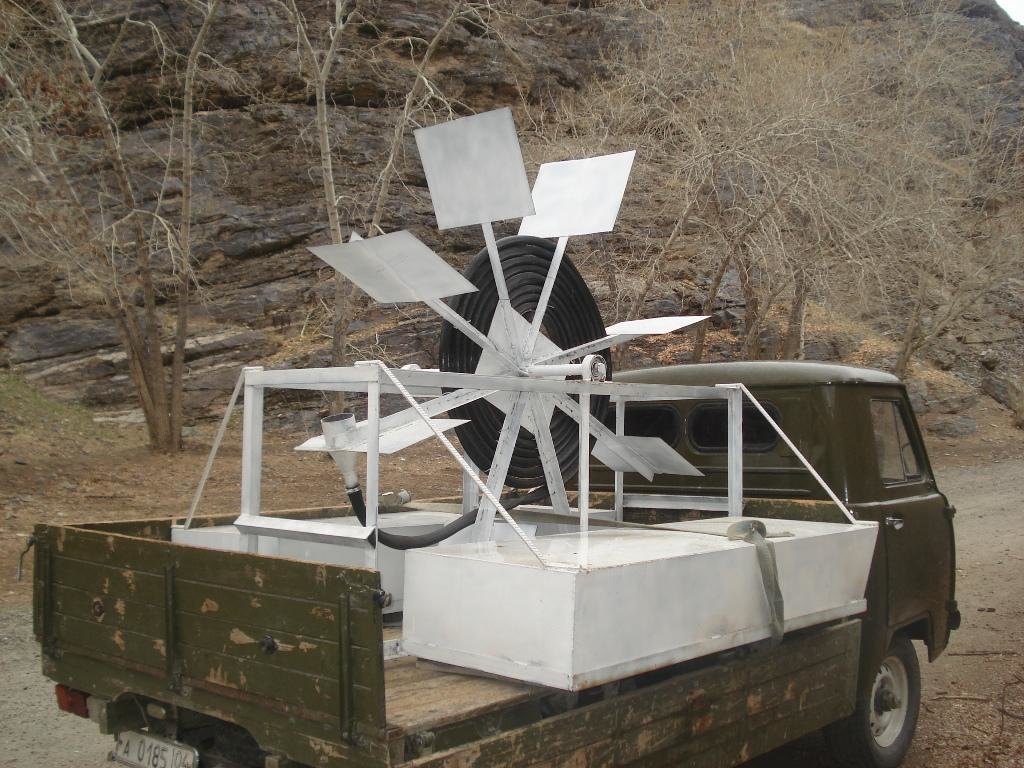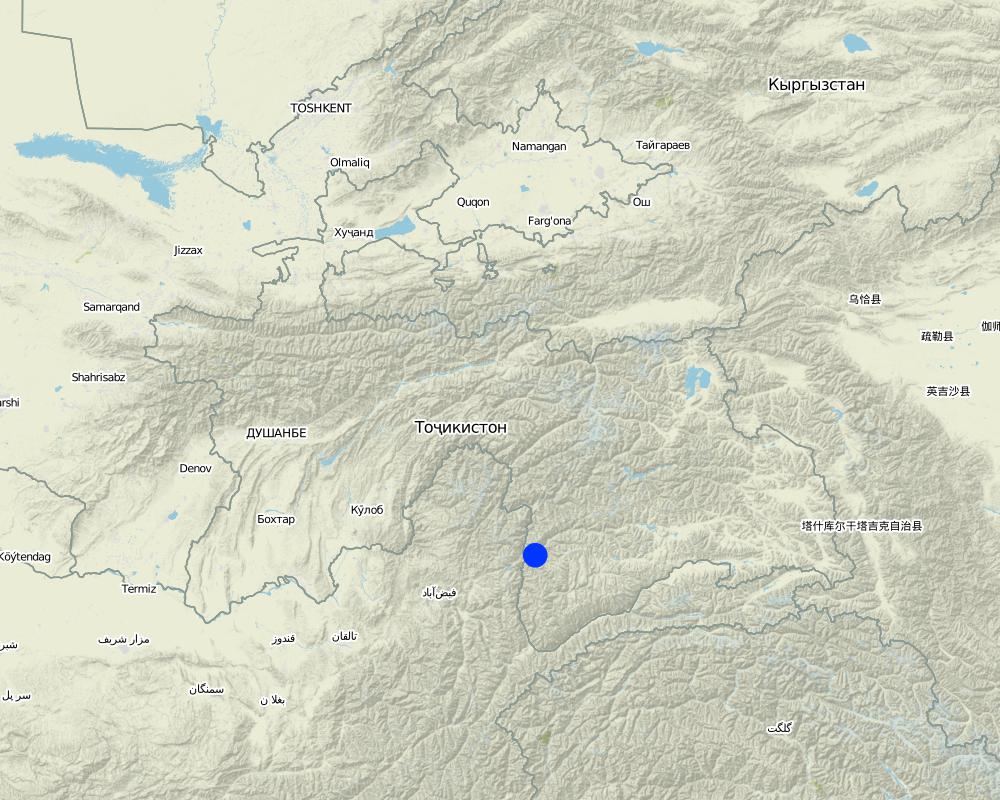Spiral water pumps [Tajikistan]
- Creation:
- Update:
- Compiler: Julie Zähringer
- Editor: –
- Reviewers: David Streiff, Alexandra Gavilano
technologies_1464 - Tajikistan
View sections
Expand all Collapse all1. General information
1.2 Contact details of resource persons and institutions involved in the assessment and documentation of the Technology
SLM specialist:
Khudonazarov Artur
Manager of the "Centre for Sustainable and Innovative Technology", a project of MSDSP
Tajikistan
SLM specialist:
Shariff Jamil
MSDSP
Name of the institution(s) which facilitated the documentation/ evaluation of the Technology (if relevant)
Kyrgyzstan Mountain Societies Development Support Programme, Aga Khan Development Network (MSDSP KG) - Kyrgyzstan1.3 Conditions regarding the use of data documented through WOCAT
The compiler and key resource person(s) accept the conditions regarding the use of data documented through WOCAT:
Yes
2. Description of the SLM Technology
2.1 Short description of the Technology
Definition of the Technology:
Spiral water pumps can carry water from the river to fields that are up to 30 metres higher than the river without the input of electricity or fuel.
2.2 Detailed description of the Technology
Description:
A Spiral tube water pump is a method of pumping water by using an undershot water wheel which has a scoop connected to a spiral tube. As the wheel turns, the scoop will alternatively introduce either water or air into the spiral tube. The pressure from the hydrostatic head generated from the column of water introduced by the scoop, is added to the pressure from previous scoops, and so as the wheel turns it will increase the water pressure with every turn of the spiral. The main characteristic of the spiral water pump is that it can pump water without the input of electricity or fuel. It works with the power of the water flow. Once built, the spiral water pump is able to push water up to 30 metres high (horizontal push) and up to 70 metres away (vertical push). The water push (how far water will be pushed horizontally and vertically) depends on how big the wheel of the Spiral Water Pump is built, and how much tube is put around the wheel.
Purpose of the Technology: The spiral tube water pumps were installed with the aim to provide irrigation water from rivers to higher level crop fields. Land users in GBAO are dependent on irrigation water to grow their crops and without the use of water pumps they can not access the water from rivers that are at a lower level than the fields.
Establishment / maintenance activities and inputs: The type, size and thus material costs of a spiral water pump will depend on 2 parameters: first, the irrigation needs (how far the water needs to go and how much is used per day) and second, the available water flow (the velocity and depth of the water source). There is only an initial investment in material for the water wheel, after that the pump should work without any further costs incurred.
Natural / human environment: The spiral water pumps were installed in 4 different districts of the semi-arid to arid GBAO region where the availability of irrigation water is crucial to crop production. So far, 4 spiral water pumps have been installed for test runs but it is very likely that they will be adopted by other farmers as they observe the benefits created by the ones that are already in place.
2.3 Photos of the Technology
2.5 Country/ region/ locations where the Technology has been applied and which are covered by this assessment
Country:
Tajikistan
Region/ State/ Province:
GBAO
Further specification of location:
Roshtkalah, Ishkashim, Vanj, Rushnan
Specify the spread of the Technology:
- evenly spread over an area
If precise area is not known, indicate approximate area covered:
- 100-1,000 km2
Comments:
1 spiral water pump was installed in each of these 4 districts
Map
×2.6 Date of implementation
If precise year is not known, indicate approximate date:
- less than 10 years ago (recently)
2.7 Introduction of the Technology
Specify how the Technology was introduced:
- through projects/ external interventions
Comments (type of project, etc.):
The first water wheels were established in 2011 by MSDSP
3. Classification of the SLM Technology
3.1 Main purpose(s) of the Technology
- access to irrigation
3.2 Current land use type(s) where the Technology is applied

Cropland
- Annual cropping
- Tree and shrub cropping
Annual cropping - Specify crops:
- cereals - wheat (spring)
- root/tuber crops - potatoes
- tomatoes, radishes, coleslaw
Tree and shrub cropping - Specify crops:
- stone fruits (peach, apricot, cherry, plum, etc)
- tree nuts (brazil nuts, pistachio, walnuts, almonds, etc.)
Number of growing seasons per year:
- 1
Specify:
Longest growing period in days: 170
Comments:
Major land use problems (compiler’s opinion): There has been less snow cover during winter time, and less precipitation in the spring, resulting in a lack of irrigation water, and a decline of soil fertility.
3.4 Water supply
Water supply for the land on which the Technology is applied:
- full irrigation
3.5 SLM group to which the Technology belongs
- irrigation management (incl. water supply, drainage)
- energy efficiency technologies
3.6 SLM measures comprising the Technology

structural measures
- S11: Others
Comments:
Main measures: structural measures
3.7 Main types of land degradation addressed by the Technology

soil erosion by water
- Wt: loss of topsoil/ surface erosion

soil erosion by wind
- Et: loss of topsoil

chemical soil deterioration
- Cn: fertility decline and reduced organic matter content (not caused by erosion)

physical soil deterioration
- Pk: slaking and crusting
- Pi: soil sealing

biological degradation
- Bc: reduction of vegetation cover
- Bq: quantity/ biomass decline
Comments:
Main type of degradation addressed: Wt: loss of topsoil / surface erosion, Et: loss of topsoil, Cn: fertility decline and reduced organic matter content
Secondary types of degradation addressed: Pk: sealing and crusting, Bc: reduction of vegetation cover, Bq: quantity / biomass decline
Main causes of degradation: change of seasonal rainfall (less precipitation and snow cover), droughts
3.8 Prevention, reduction, or restoration of land degradation
Specify the goal of the Technology with regard to land degradation:
- prevent land degradation
4. Technical specifications, implementation activities, inputs, and costs
4.1 Technical drawing of the Technology
Technical specifications (related to technical drawing):
Spiral water pump: When the wheel rotates with the power of the water, a “gulp” will add water and air into the tube at every rotation. The combination of water and air in the tube will create an increasing pressure at every rotation of the wheel. This build-up of pressure will allow the water to be pushed to a definite height.
Date: 13.05.2011
Technical knowledge required for field staff / advisors: high
Technical knowledge required for land users: high
Main technical functions: water harvesting / increase water supply, water spreading
Structural measure: spiral water pump
Construction material (other): metal, plastic tube
Author:
MSDSP Khorog
4.2 General information regarding the calculation of inputs and costs
other/ national currency (specify):
Somoni
If relevant, indicate exchange rate from USD to local currency (e.g. 1 USD = 79.9 Brazilian Real): 1 USD =:
4.5
Indicate average wage cost of hired labour per day:
9.00
4.3 Establishment activities
| Activity | Timing (season) | |
|---|---|---|
| 1. | Building a steel frame to fix two empty water tanks that keep the water pump floating (if the water source is a river, not a canal) | |
| 2. | Setting up the outer steel frame connected with axel, outrig | |
| 3. | Putting in polyethylene tube | |
| 4. | Painting wheels white | |
| 5. | None | |
| 6. | None |
4.4 Costs and inputs needed for establishment
| Specify input | Unit | Quantity | Costs per Unit | Total costs per input | % of costs borne by land users | |
|---|---|---|---|---|---|---|
| Labour | Putting in polyethylene tube | Persons/day | 5.0 | 40.0 | 200.0 | |
| Equipment | Electrode for welding | Pieces | 80.0 | 0.375 | 30.0 | |
| Construction material | Tin plates | Pieces | 7.0 | 200.0 | 1400.0 | |
| Construction material | Chain hooks | Pieces | 8.0 | 3.0 | 24.0 | |
| Construction material | Scoop | Pieces | 1.0 | 25.0 | 25.0 | |
| Construction material | Clamps | Pieces | 60.0 | 0.7 | 42.0 | |
| Construction material | Gabion grid | Pieces | 1.0 | 135.0 | 135.0 | |
| Construction material | Steel | meter | 32.0 | 8.375 | 268.0 | |
| Construction material | Axle (pipe), 32 cm | meter | 1.0 | 50.0 | 50.0 | |
| Construction material | Bushing | Pieces | 2.0 | 35.0 | 70.0 | |
| Other | Rotary fitting | Pieces | 1.0 | 200.0 | 200.0 | |
| Other | Polyethylene tube | meter | 50.0 | 13.0 | 650.0 | |
| Other | White paint | liter | 3.0 | 15.0 | 45.0 | |
| Total costs for establishment of the Technology | 3139.0 | |||||
| Total costs for establishment of the Technology in USD | 697.56 | |||||
If land user bore less than 100% of costs, indicate who covered the remaining costs:
MSDSP
Comments:
Duration of establishment phase: 3 month(s)
4.5 Maintenance/ recurrent activities
| Activity | Timing/ frequency | |
|---|---|---|
| 1. | maintenance of pump | annual |
4.6 Costs and inputs needed for maintenance/ recurrent activities (per year)
| Specify input | Unit | Quantity | Costs per Unit | Total costs per input | % of costs borne by land users | |
|---|---|---|---|---|---|---|
| Labour | Maintenance of pump | Pump | 1.0 | 45.0 | 45.0 | 100.0 |
| Total costs for maintenance of the Technology | 45.0 | |||||
| Total costs for maintenance of the Technology in USD | 10.0 | |||||
Comments:
The costs apply to the construction of 1 spiral pump.
4.7 Most important factors affecting the costs
Describe the most determinate factors affecting the costs:
The material needed to build such a spiral waterpump is the most important factor determining the costs.
5. Natural and human environment
5.1 Climate
Annual rainfall
- < 250 mm
- 251-500 mm
- 501-750 mm
- 751-1,000 mm
- 1,001-1,500 mm
- 1,501-2,000 mm
- 2,001-3,000 mm
- 3,001-4,000 mm
- > 4,000 mm
Agro-climatic zone
- semi-arid
- arid
Thermal climate class: temperate
5.2 Topography
Slopes on average:
- flat (0-2%)
- gentle (3-5%)
- moderate (6-10%)
- rolling (11-15%)
- hilly (16-30%)
- steep (31-60%)
- very steep (>60%)
Landforms:
- plateau/plains
- ridges
- mountain slopes
- hill slopes
- footslopes
- valley floors
Altitudinal zone:
- 0-100 m a.s.l.
- 101-500 m a.s.l.
- 501-1,000 m a.s.l.
- 1,001-1,500 m a.s.l.
- 1,501-2,000 m a.s.l.
- 2,001-2,500 m a.s.l.
- 2,501-3,000 m a.s.l.
- 3,001-4,000 m a.s.l.
- > 4,000 m a.s.l.
Comments and further specifications on topography:
Altitudinal zone: Also 1,001-1,500 m a.s.l.
Landforms: Rivers
Slopes on average: Rivers need to have some flow
5.3 Soils
Soil depth on average:
- very shallow (0-20 cm)
- shallow (21-50 cm)
- moderately deep (51-80 cm)
- deep (81-120 cm)
- very deep (> 120 cm)
Soil texture (topsoil):
- coarse/ light (sandy)
Topsoil organic matter:
- low (<1%)
If available, attach full soil description or specify the available information, e.g. soil type, soil PH/ acidity, Cation Exchange Capacity, nitrogen, salinity etc.
Soil fertility is low
Soil drainage / infiltration is medium
Soil water storage capacity is medium
5.4 Water availability and quality
Ground water table:
< 5 m
Availability of surface water:
poor/ none
Water quality (untreated):
poor drinking water (treatment required)
5.5 Biodiversity
Species diversity:
- low
5.6 Characteristics of land users applying the Technology
Market orientation of production system:
- mixed (subsistence/ commercial)
Off-farm income:
- less than 10% of all income
Individuals or groups:
- groups/ community
Level of mechanization:
- animal traction
- mechanized/ motorized
Gender:
- men
Indicate other relevant characteristics of the land users:
Land users applying the Technology are mainly common / average land users
Population density: 10-50 persons/km2
Annual population growth: 1% - 2%
5.7 Average area of land used by land users applying the Technology
- < 0.5 ha
- 0.5-1 ha
- 1-2 ha
- 2-5 ha
- 5-15 ha
- 15-50 ha
- 50-100 ha
- 100-500 ha
- 500-1,000 ha
- 1,000-10,000 ha
- > 10,000 ha
Is this considered small-, medium- or large-scale (referring to local context)?
- small-scale
5.8 Land ownership, land use rights, and water use rights
Land ownership:
- state
- individual, titled
Land use rights:
- communal (organized)
5.9 Access to services and infrastructure
health:
- poor
- moderate
- good
education:
- poor
- moderate
- good
technical assistance:
- poor
- moderate
- good
employment (e.g. off-farm):
- poor
- moderate
- good
markets:
- poor
- moderate
- good
energy:
- poor
- moderate
- good
roads and transport:
- poor
- moderate
- good
drinking water and sanitation:
- poor
- moderate
- good
financial services:
- poor
- moderate
- good
6. Impacts and concluding statements
6.1 On-site impacts the Technology has shown
Socio-economic impacts
Production
energy generation
Water availability and quality
water availability for livestock
irrigation water availability
Socio-cultural impacts
Livelihood and human well-being
Comments/ specify:
This has improved the amount of area that can be utilised for cultivation of several varieties of crops.
Ecological impacts
Water cycle/ runoff
harvesting/ collection of water
6.3 Exposure and sensitivity of the Technology to gradual climate change and climate-related extremes/ disasters (as perceived by land users)
Gradual climate change
Gradual climate change
| Season | increase or decrease | How does the Technology cope with it? | |
|---|---|---|---|
| annual temperature | increase | well |
Climate-related extremes (disasters)
Meteorological disasters
| How does the Technology cope with it? | |
|---|---|
| local rainstorm | well |
| local windstorm | well |
Climatological disasters
| How does the Technology cope with it? | |
|---|---|
| drought | well |
Hydrological disasters
| How does the Technology cope with it? | |
|---|---|
| general (river) flood | not well |
Other climate-related consequences
Other climate-related consequences
| How does the Technology cope with it? | |
|---|---|
| reduced growing period | well |
Comments:
Of course the technology only works if there is a water flow available, therefore a decrease in seasonal rainfall could negatively impact the performance of the spiral water pumps.
6.4 Cost-benefit analysis
How do the benefits compare with the establishment costs (from land users’ perspective)?
Short-term returns:
positive
How do the benefits compare with the maintenance/ recurrent costs (from land users' perspective)?
Short-term returns:
positive
Comments:
the spiral pumps were only installed in 2011, therefore long-term returns can not be assessed yet
6.5 Adoption of the Technology
- single cases/ experimental
If available, quantify (no. of households and/ or area covered):
4 households
Of all those who have adopted the Technology, how many did so spontaneously, i.e. without receiving any material incentives/ payments?
- 0-10%
Comments:
100% of land user families have adopted the Technology with external material support
Comments on acceptance with external material support: It was the Social Unit Development Village Organisations (SUDVO) who received the spiral water pumps from MSDSP
There is no trend towards spontaneous adoption of the Technology
Comments on adoption trend: not yet determined, as the technology has been installed only recently
6.7 Strengths/ advantages/ opportunities of the Technology
| Strengths/ advantages/ opportunities in the land user’s view |
|---|
|
The water pumps are easy to build using the manual provided How can they be sustained / enhanced? Provide an user friendly manual, listing the detailed steps of construction including materials and prices |
|
The land was not productive and now I have a good yield of fruit How can they be sustained / enhanced? Training on fruit tree cultivation. |
| Strengths/ advantages/ opportunities in the compiler’s or other key resource person’s view |
|---|
| Spiral water pumps can provide water up to 30 m higher than the river due to the system of compressed air in the spiral tubes |
| Increase of irrigation water quantity |
| The impact on crop production and thus increased farm income can not yet be assessed as the pumps were only been installed in 2011 |
|
The pumps provide water without the need for fuel or electricity which is very useful for poor rural communities How can they be sustained / enhanced? Spreading this technology among rural areas in GBAO |
| Once established the pumps do not require any further investments |
6.8 Weaknesses/ disadvantages/ risks of the Technology and ways of overcoming them
| Weaknesses/ disadvantages/ risks in the land user’s view | How can they be overcome? |
|---|---|
| It may be expensive to replace some of the parts if they wear out in a few years time. | Buy replacement parts in advance. |
| Weaknesses/ disadvantages/ risks in the compiler’s or other key resource person’s view | How can they be overcome? |
|---|---|
| Relatively high initial investment | A micro-loan might help to cover the initial investment |
7. References and links
7.1 Methods/ sources of information
7.2 References to available publications
Title, author, year, ISBN:
Shariff, Jamil et. al. Spiral water pumps. An efficient, cheap and effective solution for up-land irrigation along canals, streams and rivers. CSIT 2011.
Available from where? Costs?
jamil.shariff@akdn.org, artur.khudonazarov@yahoo.com,
Links and modules
Expand all Collapse allLinks
No links
Modules
No modules


